Updated: 08-Jan-2020
-Now we have a photograph with a front view of the inverted Y 3-cylinder Anzani that appears in the main text with a rear view.
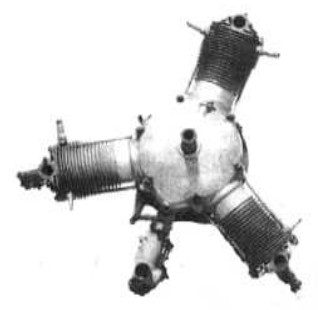
"Anzani 3-cylinder radial"
-It is water cooled with cylinders that have a bore of 4 3/16 inch, a stroke of 4 3/16 inch and a displacement of 194 cu in. It gives 35 hp at 1,800 rpm.
-And the 10-cylinder engine shown below is mentioned at the NEAM as Model B with a power improvement to 100 hp at 1200 rpm.
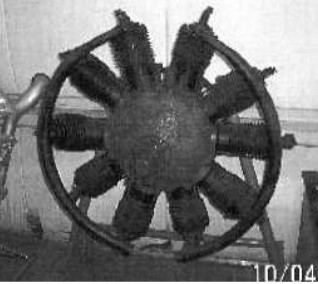
"Anzani B type"
-As an Anzani curiosity, in the year 1906, "someone" adapted an Anzani engine for a bicycle. It was driving a frontal pull propeller as to "mince meat".

"Bicycle with Anzani engine driving a propeller"
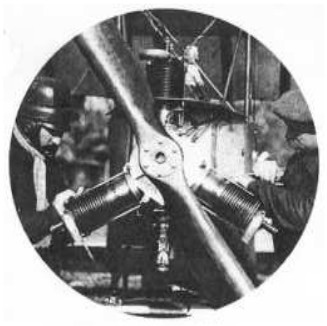
"3-cylinder Anzani in a Caudron"
-In February 2010 is the 100th anniversary of the first flight made by a Bleriot XI in Barcelona. For this reason, in Mataro (BCN) they organized a commemorative exhibition where they have shown engines and aeronautical equipment.
-Among the presented material there was a 6-cylinder Anzani that is not mentioned in the main text. It has a rounded central block instead of the lightweight one with the typical ribs of this brand's early models.

"Frontal view of the V 6-cylinder Anzani"
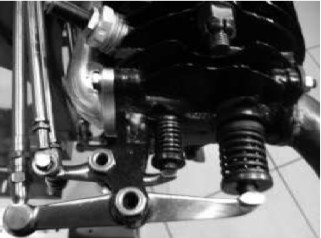
"Anzani cylinder head details"
-The two rockers have their rotation point on the same support. The inner rocker is for the intake valve and the bigger one is for the exhaust valve. Although it appears that the intake valve is much smaller than the exhaust valve, in the following illustration we can see that difference is not that much.
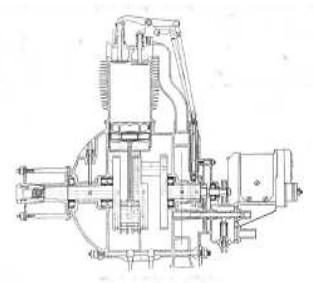
"The Anzani 6-cylinder diagram"

"Side view of the exhibited Anzani engine"
-In this last picture we see the rounded front casing instead of square ribbed one. We can also see the offset of the two three-cylinder rows.
-And as in all Anzanis and other French engines, the fateful writing "Bté SGDG" or "patented, no government guarantee." It is hard for me to understand this inhibition.
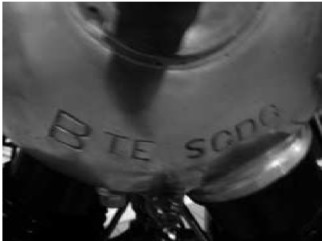
"Details of the mentioned writing"
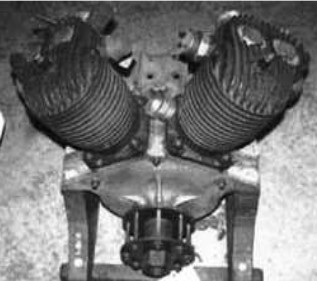
"Anzani 2V"
-This engine appears in an AEHS file as unidentified. It is displayed on a page of the Anzani main text.
-An unprecedented three-cylinder Anzani fan-shape, which has currently been restored in the Musée Régional de l'Air Angers-Marcé.
-Interestingly it has a reinforcement on the cylinder heads, with bridges that are hold in place by two studs or tie rods to the base of each cylinder.
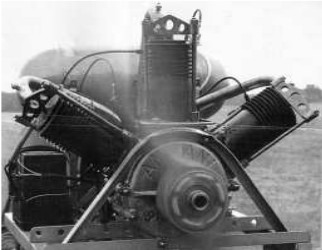
"The original Anzani with holding bridges"
-Note: A book written by Jacques Boisnard tells the restoring process.
-The water-cooled 20-cylinder radial engine appears in the following illustration with a side view. Here we can see that the front row is aligned with the back one and that the same camshaft is used for each two aligned cylinders.
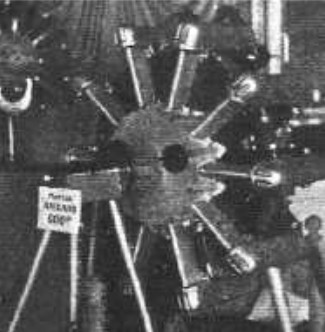
"Anzani 20-cylinder engine"
-It was presented at the 1919 Paris Air Show and its power was 600 CV.
-A new three-cylinder Anzani fan-shaped engine with studs on the cylinder heads but without the U-bolts from an earlier example.
-The studs go from the block to the cylinder head itself.
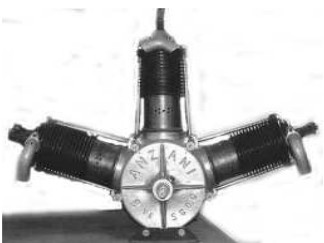
"The Anzani with the studs on the cylinders"
-It is clear that its cylinders are at 72°. And at the central crankcase next to the name in casting itself it shows the writing "Bte SGDG" or rather the "Patented Without government guarantees."
-Something that inexplicably appears on so many French wonderful engines of different brands. In other words, the French government "ignores" something that gave France an enormous prestige.
-The known double-row 10-cylinder engine is shown below in more detail. To replace the one in the main text. With its 100 CV it debuted at the Paris Air Show.
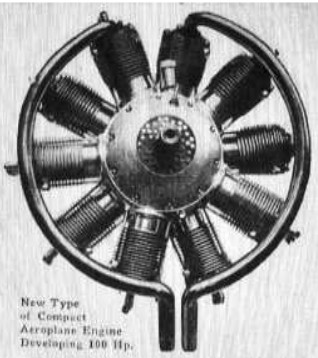
"Anzani 10-cylinder 100 CV"

"The Anzani 14-cylinder engine"
-What is calling our attention is the division of the intake ducts to the front (F) and rear (R) rows, these indeed are little harmonic.
-We have new pictures of Anzani engines that discover new features and applications of the 3-cylinder range.

"Anzani mounted on the Sanchis airplane" (PiP)
-But the most surprising was the discovery of an installation on the Fabre hydroplane, which we have always seen in distant photographs like this.
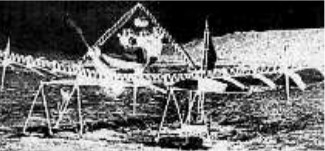
“Difficult to distinguish the powerplant” (PiP-fmr)
-This seaplane's power plant is a composite of four Anzani 12 CV, 2-cylinder, V engines.
-Another example of a multiple installation we can see in this photograph with three Anzani three-cylinder, fan-shaped engines that were mounted in an unusual way on the Ferber seaplane in 1909. Some belts are driving the main pulley.
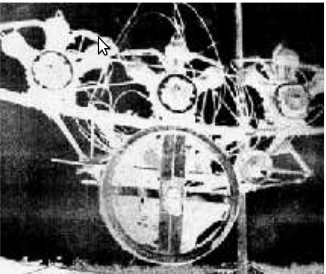
“Group of three Anzani engines” (PiP-fmr)
-From appendix 9: A two-cylinder, V aviation engine, which has been modified and has fans added for ground use, is exposed in the Nicolis Museum.
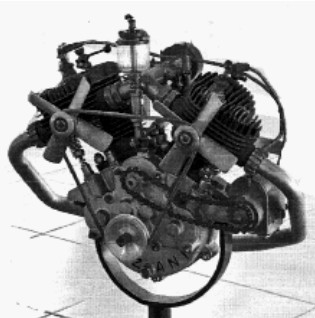
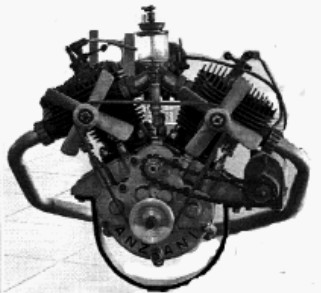
“Two views of the Anzani engine for vehicles”
-The two fans together with their pulleys and belt in front of each cylinder are clearly visible.
-The carburetor is bigger and the magneto on the side is driven by a chain.
-The work below is in the same line:

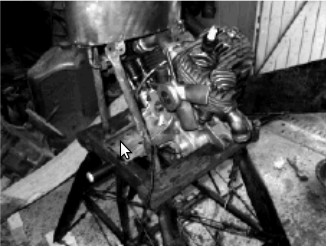
“An Anzani in a workshop, sensational”
-It is an Anzani engine intended for a machine (aircraft or ground vehicle) with propeller but with small forced cooling fans, like the engine of the previous column.
-In the pictures we see it with propeller and with fuel tank on top.
-The vehicle in question was called "Heliocycle", of a certain Leyat.
-Anzani did not only built engines for aircraft, their engines were also installed on bicycles and cars.

"Anzani 3-cylinder W engine on a bike"
-And another engine, though it looks like an Anzani and has its traces, it may be another model built currently. It even seems a scale model.
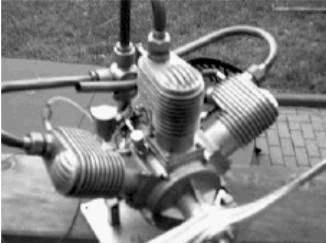
"Anzani style engine"
-In November 2012 it is confirmed to be a scale model to 1/4 with variants of Anzani 3-W or fan-shaped engine.
-Indeed, there are appearing a lot of reduced engines in recent times.
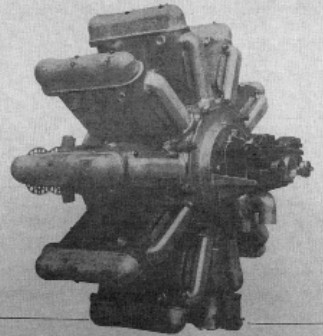
"20-cylinder water-cooled Anzani engine with 700 hp"
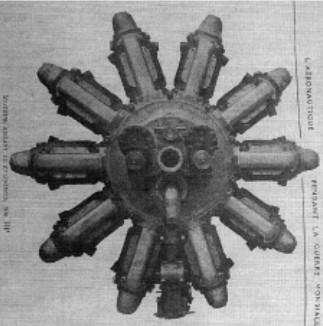
"Rear view of the same enginer"
-Extracted from an old French book "L'aéronautique pendant la guerre mondiale".
-Interestingly in this publication's last photo the engine appears misplaced, with the carburetor at 3 o'clock.
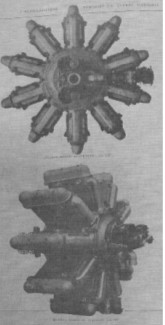
"Page with the upper engine turned 90 degrees"
-At the Museum of Brno (Czech Republic) we found a rare Anzani. It has barely fins on the cylinders (only on the cylinder heads).
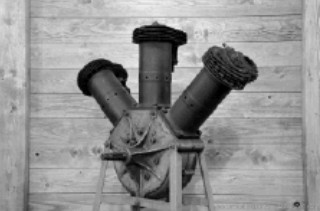
"Long cylinders and 25 CV"
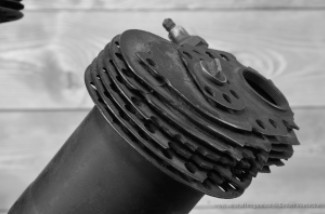
"Fins on the cylinder heads"
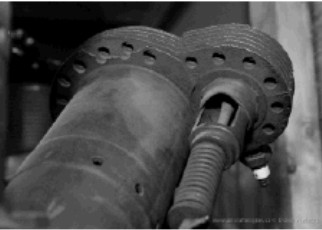
"Exhaust control details"
-The exhaust is controlled by rods and the intake is by automatic valve. This engine lacks the three intake ducts and the carburetor.
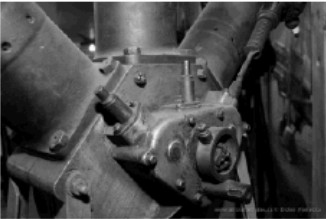
"Distribution”"
-On the rear we see the exhaust camshaft box and the ignition contact breaker.
-Another Note: A recent picture of an Anzani three-cylinder engine on a working bench for demonstrations. It has old elements like the yellow-brass gas tank. The battery box is simulated for it works with two small batteries located on the engine's left side.

"Anzani 3-cylinder engine"
-It shows the clamps on the cylinder heads and the cylinder anchor bolts.
-Another note: A drawing of a six-cylinder, fan-shaped, water-cooled engine. We can see the connecting rod system as well as the valves: automatic and controlled.

"Anzani 6-cylinder connecting rod system"
-Another Note: A curious application of a three-cylinder Anzani radial on a unicycle is shown in the pictures below.

“There were actually other similar applications”
-The same example of an application of this famous motor. This "unicycle" was designed by Alfred D'Harlingue.
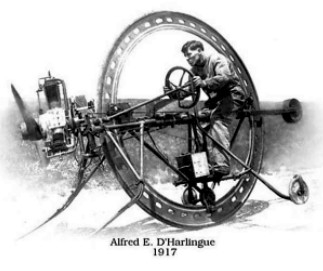
"Unicycle with Anzani engine"
From appendix 10: In the technical museum of Helsingor, Denmark, the following Anzani is exposed. E.V. sent us the picture with a semi-rear view of the engine, which shows us interesting details.

"Anzani nearly from the rear"

"And a rear view"
-There are some draining taps on the cylinder heads. The valve group is a body that has fins attached to the cylinder head with a controlled exhaust valve (although at the base of the cylinders are holes at the stroke end) and an automatic intake valve, ie it opens with aspiration. The inlet-ducts, which fit on the body of these valves, are missing.
-Nice printed header for letter / invoice / etc. used by the Anzani company.
-It shows the engines that were in production at that time.
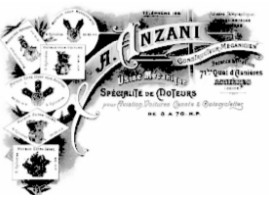
"Letterhead used by Anzani"
-Following the brand's history we see that since the beginning of motorized aviation until the company's cease it was remarkably successful.
-We located an image with a rear view of the 5-cylinder engine that gave 100 hp with a spectacular intake manifold.

“Anzani 5-cylinder rear view”
This spider type intake manifold has a very special look.
-The carburetor is even more special. Apparently it is simple, but it is not.
-It is a G&A carburetor. The illustration above doesn't show the float chamber, but it should have it as we can see in the image below).
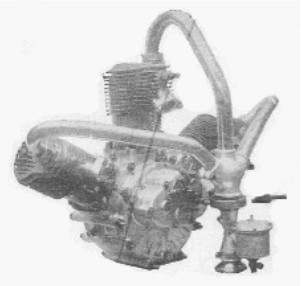
“The arrow indicates the special device”
-It is worthwhile watching the G&A carburetor more closely. Here it appears with float chamber.
-With the arrow pointing a collar within which there are bronze balls of different sizes to be progressively lifted, automatically compensating the mixture, entering more or less auxiliary air at high or low engine speeds.
-As they are aspirated through their weight, they are plugging holes, so closing additional air inlet.
-The carburetor's brand presumes -presumed- that it requires no adjustments, without purging, and here they do mention that it does not need a "level floater" like in the photo of the Anzani 5-cylinder engine.
-Higher up there is the rotary valve or throttle wrapped by a chamber that could be for hot water or hot air -exhaust-, to prevent freezing.

"The arrow indicates the ball cage"
-Here is another Anzani model with three cylinders at 72° -so it seems-, with additional exhaust ports at the cylinder base near the oil inlet for the piston skirts.

“Another view of an Anzani 3-cylinder engine”
-New view of an Anzani 3-cylinder fan-shape engine. With a cut crankcase and the absence of an intake duct from the manifold.
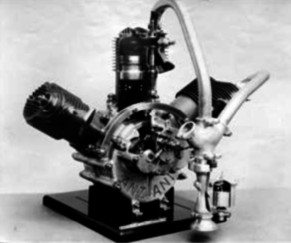
"Anzani 3-cylinder"
Engines of ANZANI, 2nd part
We have no more detailed engine information for this brand. We continue our search. Any help will be appreciated.


